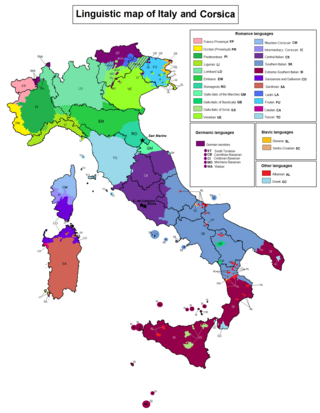
Luigi Antonio Lanzi was an Italian art historian and archaeologist. When he died he was buried in the church of the Santa Croce at Florence by the side of Michelangelo.
Mauro Cristofani was a linguist and researcher in Etruscan studies.
Mario Torelli was an Italian scholar of Italic archaeology and the culture of the Etruscans. He taught at the University of Perugia.

Massimo Pallottino was an Italian archaeologist specializing in Etruscan civilization and art.

The Cippus Perusinus is a stone tablet (cippus) discovered on the hill of San Marco, near Perugia, Italy, in 1822. The tablet bears 46 lines of incised Etruscan text, about 130 words. The cippus, which seems to have been a border stone, appears to display a text dedicating a legal contract between the Etruscan families of Velthina and Afuna, regarding the sharing or use, including water rights, of a property upon which there was a tomb belonging to the noble Velthinas.

Gallo-Italic of Sicily is a group of Gallo-Italic languages found in about 15 isolated communities of central eastern Sicily. Forming a language island in the otherwise Sicilian language area, it dates back to migrations from northern Italy during the reign of Norman Roger I of Sicily and his successors.
Lammert Bouke van der Meer is a Dutch classicist and classical archaeologist specialized in Etruscology. He studied classics and archaeology at the University of Groningen, and received his Ph.D. from the same university in 1978 with a dissertation entitled Etruscan urns from Volterra. Studies on mythological representations, I-II. Van der Meer is retired associate professor of Classical Archaeology at Leiden University.
Nancy Thomson de Grummond is the M. Lynette Thompson Professor of Classics and Distinguished Research Professor at Florida State University. She specializes in Etruscan, Hellenistic and Roman archaeology. She serves as the director of archaeological excavations at Cetamura del Chianti in Tuscany, Italy. Her current research relates to Etruscan and Roman religion, myth and iconography.

Alfredo Trombetti, was an Italian linguist active in the early 20th century.
Christopher John Smith, FRSE, FSA, FRHistS, is a British academic and classicist specialising in early Ancient Rome.

Rofalco was a fortified late-Etruscan settlement, located about twenty km north of Vulci, at the edge of the Selva del Lamone volcanic plateau. The site controlled the important natural route formed by the valley of the Olpeta stream and contributed to the defense and the organization of the southeastern portion of the ancient territory of Vulci.

Su Romanzesu is an archaeological site that is located near Bitti, Nuoro Province, Sardinia.

Salvatore Satta was an Italian jurist and writer. He is famous for the novel The Day of Judgment (1975), and for several important studies on civil law.
Maria Bonghi Jovino is an Italian archaeologist. Bonghi Jovino was Professor of Etruscology and Italic Archaeology at the University of Milan.
Carlo De Simone was an Italian linguist, specializing in Ancient Greek and Latin texts and Etruscan epigraphs. He is best known for his research into Etruscan, Lemnian and Rhaetian languages.

Istituto Nazionale di Studi Etruschi ed Italici is a cultural institution based in Florence, Tuscany, Italy. It was founded in 1925 with the aim of promoting and enhancing in Italy and worldwide studies on the Etruscan civilization and other peoples of ancient Italy.
Jean MacIntosh Turfa is an American archaeologist and authority on the Etruscan civilization.

Maria Floriani Squarciapino (1917-2003) was an Italian classical archaeologist and professor at La Sapienza University in Rome, known for her work on the Roman port city of Ostia.

Francesco Salata was a Dalmatian Italian senator, politician, journalist, historian and writer. Salata was an irredentist, although he had a more legalistic approach than other contemporaries, as well as being more liberal. He was panned and attacked by the fascists, although, after they took power, he was employed by the fascist government, and wrote books apologizing for the fascist politics. Very fond of his native Istria, Salata opposed what he saw as the slavicisation carried out by Croatian priests in Istria, the Kvarner and Dalmatia. He accused the Slovenian and Croatian clergy of carrying out the slavicisation of Istria and the Kvarner. Salata upheld the idea that Dalmatia, Istria and the Kvarner were, historically, Italian lands.
Carlo Francovich was an Italian politician, partisan and literary historian.
This page is based on this
Wikipedia article Text is available under the
CC BY-SA 4.0 license; additional terms may apply.
Images, videos and audio are available under their respective licenses.










